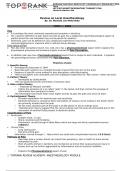Summary
Summary Local Anesthesiology
- Course
- Institution
Pain • It is perhaps the most commonly experienced symptom in dentistry. • Yet, a precise definition of pain does not exist as pain has a subjective/ psychophysiological aspect (a painful stimuli for one individual may not be painful for another) • Arbitrarily, pain can be defined as any u...
[Show more]



